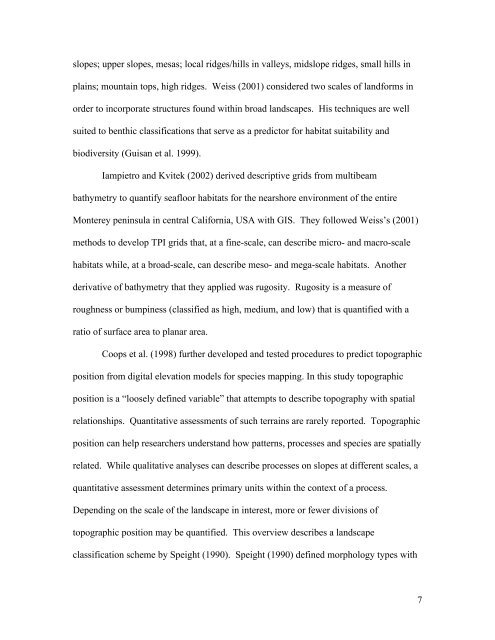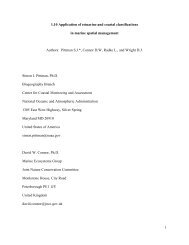A Benthic Terrain Classification Scheme for American Samoa
A Benthic Terrain Classification Scheme for American Samoa
A Benthic Terrain Classification Scheme for American Samoa
Create successful ePaper yourself
Turn your PDF publications into a flip-book with our unique Google optimized e-Paper software.
slopes; upper slopes, mesas; local ridges/hills in valleys, midslope ridges, small hills in<br />
plains; mountain tops, high ridges. Weiss (2001) considered two scales of land<strong>for</strong>ms in<br />
order to incorporate structures found within broad landscapes. His techniques are well<br />
suited to benthic classifications that serve as a predictor <strong>for</strong> habitat suitability and<br />
biodiversity (Guisan et al. 1999).<br />
Iampietro and Kvitek (2002) derived descriptive grids from multibeam<br />
bathymetry to quantify seafloor habitats <strong>for</strong> the nearshore environment of the entire<br />
Monterey peninsula in central Cali<strong>for</strong>nia, USA with GIS. They followed Weiss’s (2001)<br />
methods to develop TPI grids that, at a fine-scale, can describe micro- and macro-scale<br />
habitats while, at a broad-scale, can describe meso- and mega-scale habitats. Another<br />
derivative of bathymetry that they applied was rugosity. Rugosity is a measure of<br />
roughness or bumpiness (classified as high, medium, and low) that is quantified with a<br />
ratio of surface area to planar area.<br />
Coops et al. (1998) further developed and tested procedures to predict topographic<br />
position from digital elevation models <strong>for</strong> species mapping. In this study topographic<br />
position is a “loosely defined variable” that attempts to describe topography with spatial<br />
relationships. Quantitative assessments of such terrains are rarely reported. Topographic<br />
position can help researchers understand how patterns, processes and species are spatially<br />
related. While qualitative analyses can describe processes on slopes at different scales, a<br />
quantitative assessment determines primary units within the context of a process.<br />
Depending on the scale of the landscape in interest, more or fewer divisions of<br />
topographic position may be quantified. This overview describes a landscape<br />
classification scheme by Speight (1990). Speight (1990) defined morphology types with<br />
7
















